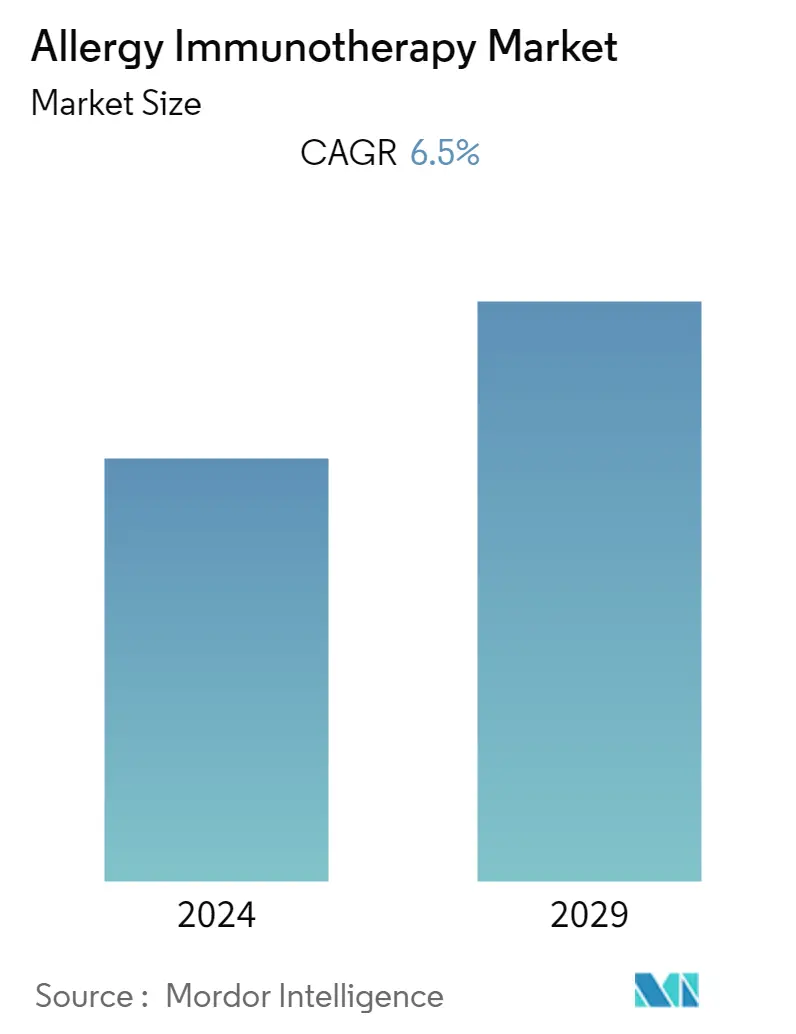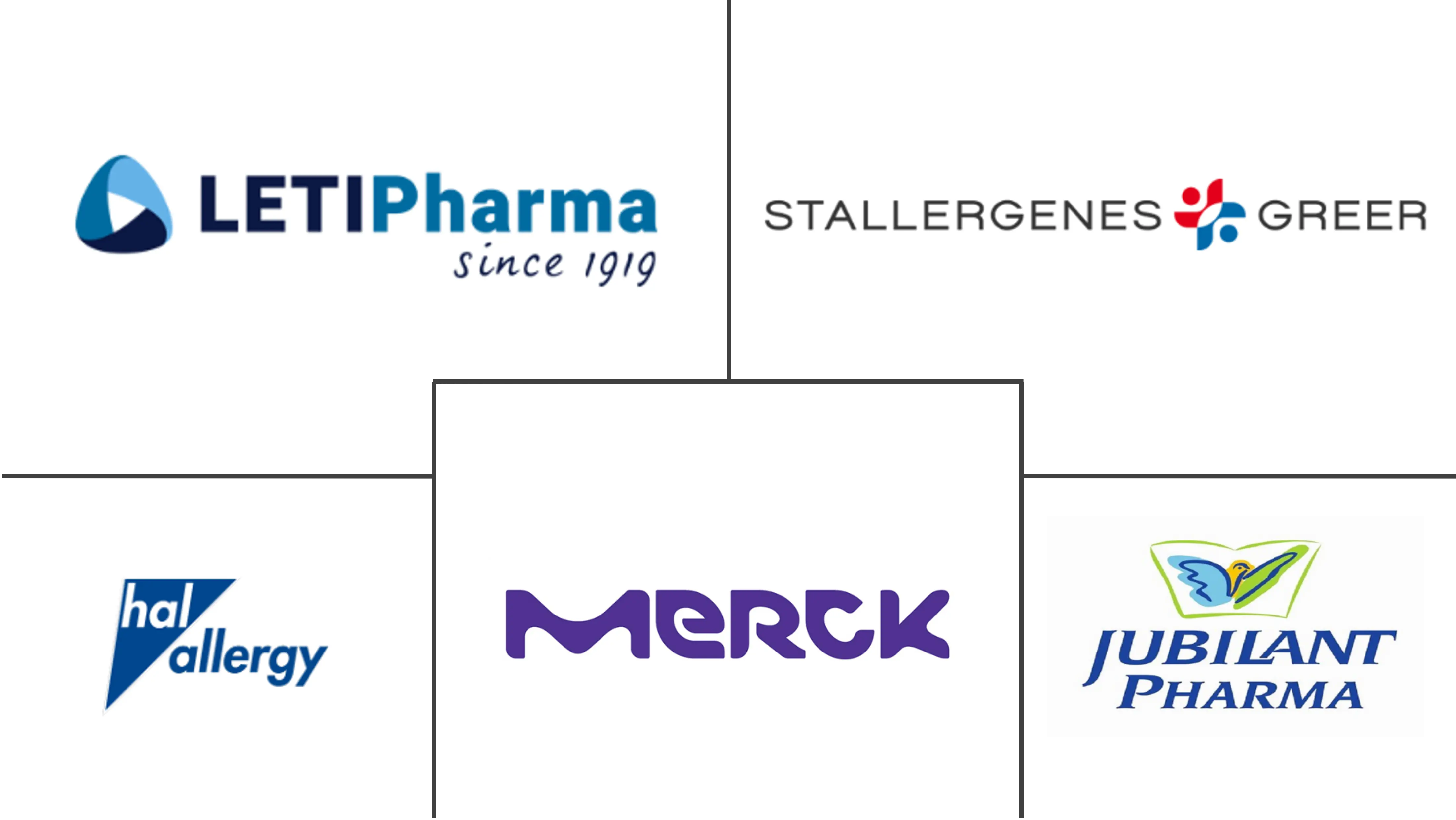Market Size of Allergy Immunotherapy Industry

| Study Period | 2019 - 2029 |
| Base Year For Estimation | 2023 |
| CAGR | 6.50 % |
| Fastest Growing Market | Asia-Pacific |
| Largest Market | North America |
| Market Concentration | High |
Major Players
*Disclaimer: Major Players sorted in no particular order |
Allergy Immunotherapy Market Analysis
The Global Allergy Immunotherapy Market size is expected to grow from USD 2.2 billion in 2023 to USD 3.04 billion by 2028, at a CAGR of 6.5% during the forecast period (2023-2028).
The COVID-19 pandemic adversely affected communities, industries, businesses, and lives across the world. Many companies received approval for their vaccines against the SARS-CoV-2 virus and still focusing their research and development on the development of therapeutics against COVID-19. However, allergy patients needed continuous treatment and medication supply owing to which healthcare professionals continued to give treatments or treatment advice during the pandemic. For instance, according to the study published in February 2021, by Allergy, Asthma & Immunology Research, it was recommended that allergic patients who were suffering from asthma, rhinitis, atopic dermatitis, or chronic urticaria should continue to receive maintenance therapy in a well-controlled manner during the pandemic. Furthermore, according to the study published in February 2021, by Current Allergy and Asthma Reports, to continue treatment of allergic rhinitis, remote health care tools for first visits or monitored patients were implemented during pandemic and it also suggested to continue treatment in case of uninfected patients or recovered from COVID-19 infection and interrupt in case of positive or suspected SARS-CoV-2 infection. Therefore, such instances indicate that the market continue to grow even after the pandemic.
The increasing burden of various types of allergies and launch of new sublingual immunotherapies in emerging economies are the major drivers for the market. The increasing burden of various types of allergies is one of the key drivers for the market. For instance, according to the journal published by the SingleCare in January 2022, more than 50.0 million Americans suffers from some type of allergy every year. It also reported that allergies are the sixth leading chronic illness in the United States. A survey was also conducted by SingleCare in 2021, which reported that 82.0% of respondents with allergies reported these allergies affects the quality of life in the United States. The survey result also showed that 14.0% of the respondents reported hospitalizations due to an allergic reaction. Therefore, such an increasing cases of allergies is anticipated to propel the demand for allergy immunotherapy thereby propelling the market growth over the forecast period.
Furthermore, the increasing focus of the companies on research and development activities to develop novel dallergy immunotherapy to cater to high unmet medical needs is highly impacting the market's growth. In February 2023, Nectar Life Sciences launched of its innovative comprehensive allergy care platform, Nectar. The first product offering from the company's allergy treatment program, Nectar Allergy Drops, are personalized, industry-proven sublingual immunotherapy drops to provide life-long relief from allergies by treating the root cause.
However, lack of awareness about allergy and treatments is expected to hinder the market growth over the forecast period.
Allergy Immunotherapy Industry Segmentation
As per the scope of this report, allergy immunotherapies are a preventive treatment for allergic reactions to substances. It involves gradually increasing doses of the substance, or allergen, to which the person is allergic. The allergy immunotherapy market is segmented by type of immunotherapy (subcutaneous immunotherapy (SCIT) and sublingual immunotherapy (SLIT)), allergy type (allergic rhinitis, asthma, food allergy, and others), and geography (North America, Europe, Asia-Pacific, Middle East, and Africa, and South America). The market report also covers the estimated market sizes and trends for 17 different countries across major regions, globally. The report offers the value (in USD million) for the above segments.
| By Type of Immunotherapy | |
| Subcutaneous Immunotherapy (SCIT) | |
| Sublingual Immunotherapy (SLIT) |
| By Allergy Type | |
| Allergic Rhinitis | |
| Asthma | |
| Food Allergy | |
| Others |
| Geography | ||||||||
| ||||||||
| ||||||||
| ||||||||
| ||||||||
|
Allergy Immunotherapy Market Size Summary
The allergy immunotherapy market is poised for significant growth, driven by the increasing prevalence of allergies and the introduction of new sublingual immunotherapies in emerging markets. Despite the challenges posed by the COVID-19 pandemic, which initially diverted attention towards vaccine development, the demand for continuous allergy treatment remained steady. Healthcare professionals ensured that patients with conditions such as asthma and allergic rhinitis received ongoing care, often utilizing remote healthcare tools. This sustained need for treatment has contributed to the market's resilience and growth. The market is further bolstered by the focus on research and development, with companies like Nectar Life Sciences launching innovative allergy care platforms aimed at addressing unmet medical needs.
Subcutaneous immunotherapy (SCIT) remains a cornerstone of allergy treatment, offering both symptomatic relief and long-term immune system modification. Its high efficacy and cost-effectiveness are key factors driving its demand, particularly in North America, where the market is expected to dominate. The region's growth is supported by a high incidence of allergies and increased awareness of treatment options. The competitive landscape is characterized by a few major players, including Merck KGaA and Stallergenes Greer, who are actively involved in product launches and strategic partnerships. These dynamics, coupled with regulatory approvals and ongoing clinical trials, are anticipated to propel the market forward, addressing the growing need for effective allergy management solutions.
Allergy Immunotherapy Market Size - Table of Contents
-
1. MARKET DYNAMICS
-
1.1 Market Overview
-
1.2 Market Drivers
-
1.2.1 Increasing Burden of Various Types of Allergies
-
1.2.2 Launch of New Sublingual Immunotherapies in Emerging Economies
-
-
1.3 Market Restraints
-
1.3.1 Lack of Awareness about Allergy and Treatments
-
-
1.4 Porter's Five Force Analysis
-
1.4.1 Threat of New Entrants
-
1.4.2 Bargaining Power of Buyers/Consumers
-
1.4.3 Bargaining Power of Suppliers
-
1.4.4 Threat of Substitute Products
-
1.4.5 Intensity of Competitive Rivalry
-
-
-
2. MARKET SEGMENTATION (Market Size by Value - USD)
-
2.1 By Type of Immunotherapy
-
2.1.1 Subcutaneous Immunotherapy (SCIT)
-
2.1.2 Sublingual Immunotherapy (SLIT)
-
-
2.2 By Allergy Type
-
2.2.1 Allergic Rhinitis
-
2.2.2 Asthma
-
2.2.3 Food Allergy
-
2.2.4 Others
-
-
2.3 Geography
-
2.3.1 North America
-
2.3.1.1 United States
-
2.3.1.2 Canada
-
2.3.1.3 Mexico
-
-
2.3.2 Europe
-
2.3.2.1 Germany
-
2.3.2.2 United Kingdom
-
2.3.2.3 France
-
2.3.2.4 Italy
-
2.3.2.5 Spain
-
2.3.2.6 Rest of Europe
-
-
2.3.3 Asia-Pacific
-
2.3.3.1 China
-
2.3.3.2 Japan
-
2.3.3.3 India
-
2.3.3.4 Australia
-
2.3.3.5 South Korea
-
2.3.3.6 Rest of Asia-Pacific
-
-
2.3.4 Middle-East and Africa
-
2.3.4.1 GCC
-
2.3.4.2 South Africa
-
2.3.4.3 Rest of Middle-East and Africa
-
-
2.3.5 South America
-
2.3.5.1 Brazil
-
2.3.5.2 Argentina
-
2.3.5.3 Rest of South America
-
-
-
Allergy Immunotherapy Market Size FAQs
What is the current Global Allergy Immunotherapy Market size?
The Global Allergy Immunotherapy Market is projected to register a CAGR of 6.5% during the forecast period (2024-2029)
Who are the key players in Global Allergy Immunotherapy Market?
Merck KGaA (Allergopharma), Jubliant Pharma (Hollister Allergy), Leti Pharma, Stallergenes Greer and ALK-Abello A/S are the major companies operating in the Global Allergy Immunotherapy Market.

